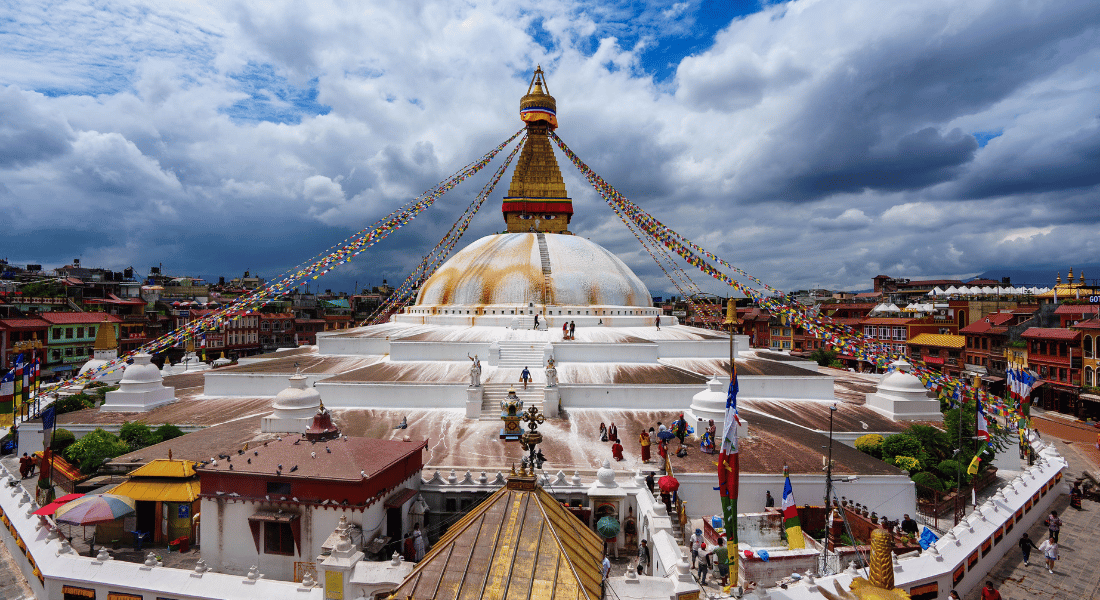Nepal is a multireligious, multicultural nation with a wealth of ancient historical and cultural landmarks. Being the second largest religion in the country, Buddhism is not just considered a religion but is taken as a way of life by many Nepalese. Which is the very reason why this religion has spread all over the world and has marked its presence with beautiful landmarks. Nepal, where the most famous among all Buddhas, Gautam Buddha, was born, is one of the most desired pilgrimage spots for many Buddhists all around the world and holds some of the most sacred sites in Buddhism. Among the numerous Buddhist pilgrimage sites in Nepal, like Lumbini, Kapilvastu, and Swayambhunath, the Boudhanath Stupa has grown to be one of the most important and well-known in the country.
Located around 9 km from the city center with a towering height of 43.03 meter and a massive size with a diameter of 110 metres, the Boudhanath Stupa is one of the largest stupa structures in the world. Also known as Khasti Chaitya by Newars (indigenous people of the Kathmandu Valley) or Jarung Khasor by Tibetan people, the Boudha Stupa’s origin is steeped in folklore and mythical stories. As the stupa is believed to have been built upon the remains of the Kashyap Buddha and is said to contain a finger of Gautam Buddha, the religious significance of this site can’t be justified in words. Due to its significance, history, and sheer beauty, thousands of pilgrims and enthusiasts get attracted to this serene area, making it the central hub of Tibetan Buddhism in Nepal.
Related Read: Buddhist Pilgrimage Sites in Nepal
Boudhanath Stupa Facts
Here are some facts related to Boudhanath Stupa:
|
Site Name |
Boudhanath Stupa |
|
Other Name |
Tibetan Name: Jarung Kashor Newari Name: Khasti Chaitya |
|
Location |
Boudha, Kathmandu |
|
Affiliation |
Buddhism |
|
Architecture Style |
Dome Style |
|
Height |
43.3 metres |
|
Area |
7631.06 sq. mt. |
|
UNESCO World Heritage Site |
1979 AD |
|
Major Festivals |
|
|
Entry Fee |
SAARC: NRP 100 Foreigner: NRP 400 Nepalese: Free |
|
Opening Hours |
Stupa: 09:00 AM - 06:00 PM Stupa Complex: 24/7 |
Boudhanath Stupa Origin and History
According to an ancient written source, Gopalarajavamsavali (a 14th-century handwritten manuscript of Nepal), the Boudhanath was founded by the Licchavi King Sivadeva. However, other Nepalese chronicles date it around the reign of King Manadeva. Which is why the Boudhanath Stupa’s origin is steeped in myths and folklore in Nepalese as well as Tibetan tradition. Two mythical stories have been widely believed by the people about the Boudhanath Stupa’s origin:
Newari Buddhism Belief
According to Buddhist Newars, one day during the reign of King Vishwadeva, the third king of the Lichavi Dynasty, the ancient spout inside Narayanhiti suddenly dried up. Worried about this unusual occurrence, the king sought help from the royal astrologer to fix this problem. The astrologer advised the king to give a sacrifice of a person who has all the 32 virtues (बत्तीस लक्षण) for the water to flow again. The problem was that there were only 2 people having all of the 32 virtues in the kingdom besides the king himself, who were his two sons. To solve this dilemma, the king decided to sacrifice himself for the greater good. Vishwadeva then ordered his son Mandeva to slay the man who would be sleeping above the spout on the fortnight without seeing his face. Mandeva, respecting his father’s command, slayed the man who was sleeping there on the fortnight. As the sacrifice was made, water gushed out of the spout at the same time, and Mandeva returned to the palace. The following morning, he found out the identity of the man he had slain the previous night and was devastated. With remorse, Mandeva went to his patriarchal deity (कुलदेवता), Vajrayogini, in Sankhu for repentance.
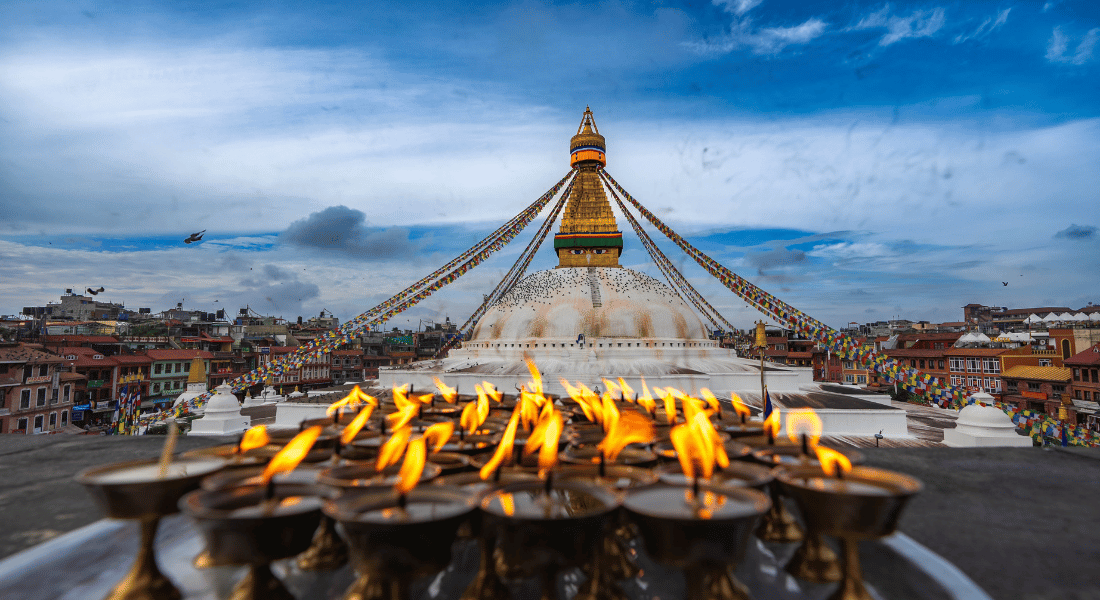
In Sankhu the goddess Maniyogini told him to build a stupa to get free from the sin of patricide (पितृहत्या). In order to determine the location, the goddess released a Kalij and wherever it landed was chosen to be the construction ground of the great stupa, which is the place where the present Boudhanath Stupa is located. Following her order, Mandeva started the construction of the stupa at that place. But the hurdle was not over; due to his sins, drought occurred in the kingdom for 12 years. So the workers spread out sheets of cloth each night to collect water from the dew and wrung them the next morning to carry out the construction of the Stupa. After 12 years the construction of the stupa was finally finished and Mandeva’s sin was cleared.
As per this belief that the Boudhanath stupa was constructed by collecting the dew drop, Newar people call it Khasti, which is a combination of two words: “Khasu” meaning dew and “Ti” meaning drops.
Tibetan Buddhism Belief
Tibetan people have their own belief on the origin of the Boudhanath Stupa. The sacred text Nidhigrantha of Guru Padmasambhava has attempted to describe the stupa’s origin and its value in Tibetan Buddhism.
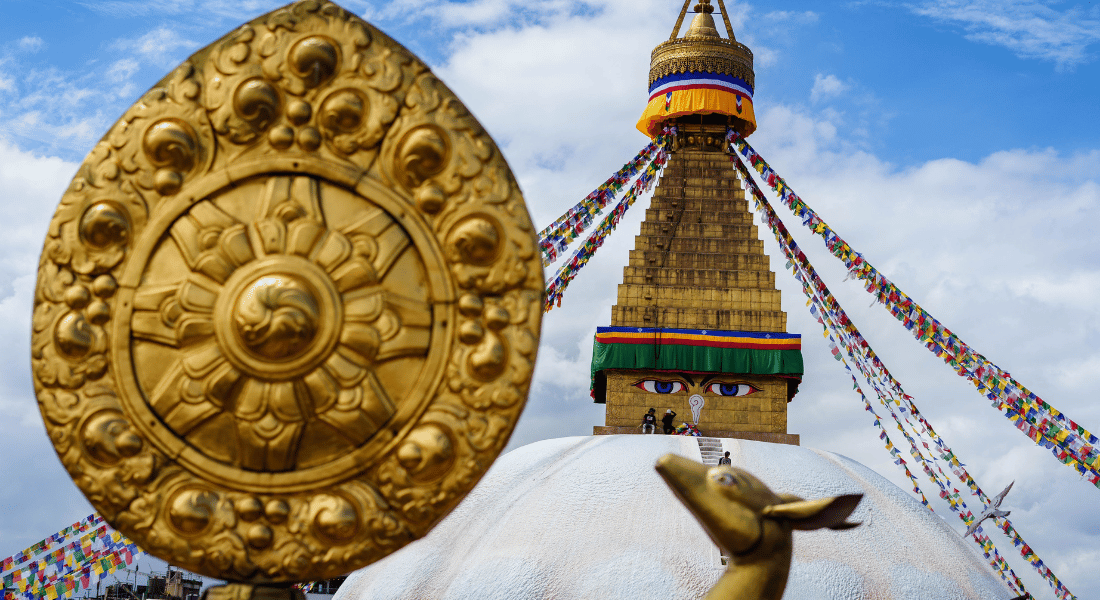
According to the text, a widow, known as Jhyazima, a poultry farmer, wished to build a stupa from her savings. So, she went to the king of that time to ask for a piece of land to build the stupa upon. The king, happy to hear Jhyazima’s untainted wish, granted the land she asked for to build the sacred stupa. Jyazima, along with her 4 sons from 4 different husbands, started the construction of the great stupa.
As the construction progressed, the sheer size of the stupa mesmerized everyone and envied the work. People asked the king to relinquish the land from her that he had provided for building the stupa, but the king said that it had already been spoken out from his mouth for the construction of the stupa. This is where the name “Jarung Khasor” came from, which is the Tibetan name of the Boudhanath Stupa. The name is composed of two words: “Jhya-ru-rung”, which means “I’ve said okay to work” and “Khane-shyor,” which means “word spoken through the mouth”. Even after that incident, the construction of the stupa didn’t stop. Unfortunately, Jyazima died before the completion of the stupa, and her 4 sons, along with the servants and animal workers, including an elephant, a monkey, and a raven, continued with the work and later consecrated the stupa with Kashyap Buddha’s relic.
After completion of the stupa, all the 4 sons, along with other helpers, prayed in front of the great stupa and wished to spread the words of Buddhism throughout Tibet. Because of this wish, all of them, including the 4 sons, the servant, and the animal helpers, got reborn in Tibet. Towards the last quarter of the eighth century, Padmasambhava, at the consecration ceremony of the mandala at the Samye Monastery in Tibet, described the story of the Jarung Khasor. He reminded all that the 4 sons that have been reborn were the king Trisong Deuchen, Acharya Shantrarakshit, Minister Bamu Thiser, and himself, whereas the servant was reborn as Minister Go Pema Ghungchen and the animal helpers were also reborn as humans.
Boudhanath Stupa Significance
Among many Buddhist temples and stupas around Nepal, the Boudhanath Stupa is regarded as one of the most sacred pilgrimage sites in the country. The historical, religious, and cultural significance of the stupa attracts numerous pilgrims and visitors alike from all around the world.
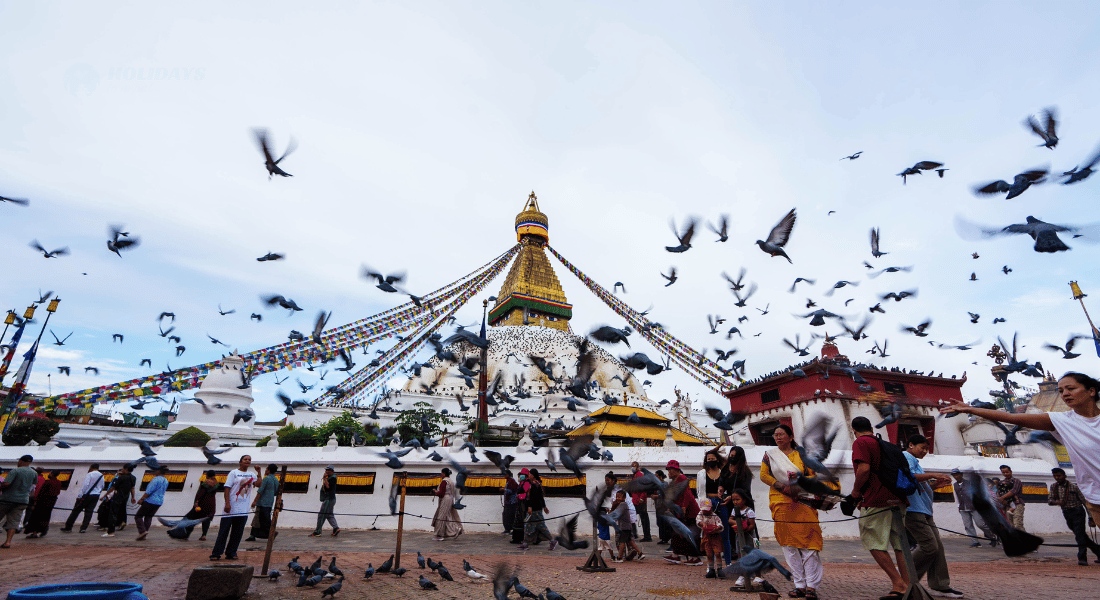
Religious Significance
Considered sacred by Buddhists from different sects, the Boudhanath Stupa is regarded as the major pilgrimage site in the world. The Tibetan people especially consider the stupa of immense significance due to its connection with Guru Padmasambhava and believe it to be the source from where the word of Buddhism spread throughout Tibet. It is widely believed that Guru Padmasambhava, in his previous life, was a part of the construction of this sacred monument along with his 3 brothers, servants, and animal helpers, who also became significant individuals who contributed to the spread of Buddhism in Tibet in their next life.
Additionally, different parts of the stupa’s structure symbolise various elements (land, water, fire, air, and ether) and aspects of Buddhist cosmology, including the path to Buddhahood. The stupa is believed to contain the remains of the Kashyap Buddha, who is the 27th of the 29 named buddhas. It is also known as Chinataamani, meaning the wish-fulfilling jewel, which is why numerous pilgrims visit and circumambulate the stupa, spinning the mantra wheel to get their wishes fulfilled. The Buddhist Newars also consider this site sacred and believe that the stupa holds the finger of Gautama Buddha and also consider the Aji Ma situated next to the entry point of the stupa to be the guardian deity of the children around Bouddha. Moreover, the Boudhanath Stupa hosts many religious festivals like Buddha Jayanti, Lhosar, Chechyu puja, etc., enhancing the spiritual ambience of the site even more.
Cultural Significance
Boudhanath is not just a religious site but is also a cultural hub. In ancient times, this site was located on the trade route from Tibet to India, which enters the Kathmandu Valley from the Sankhu Village. Adding to this, during the 1959 Tibetan uprising, a significant number of Tibetan refugees migrated to Nepal and settled around Boudhanath Stupa. These are the reasons why there is a major influence of Tibetan culture around the stupa. Around the stupa, visitors can find various shops selling Tibetan souvenirs and restaurants with Tibetan cuisines like the thukpa (noodle soup), keema noodles (noodles with minced meat), sha phaley, etc.
Additionally, the Boudhanath Stupa is also culturally significant to native ethnic groups like the Newars, Tamangs, Gurungs, etc. in Nepal. The Newars call it the Khasti Chaitya, meaning the stupa made using the water from “Khasu” dew and “Ti” drops. They regard the stupa as sacred in their culture and consider the Harati Ajima their protector and celebrate a festival called the Mamla Jatra to honor the deity in the vicinity. Similarly, the Tamangs celebrate the Temal Jatra in Boudhanath in honor of their ancestors and recently deceased parents or relatives.
Boudhanath Stupa Architecture
Besides the historical and spiritual significance of the Boudhanath Stupa, its unique architecture, design, and size make it a remarkable site worthy of a visit. The 43.3-meter-tall and 110-meter-wide Boudhanath Stupa is an ancient architectural masterpiece of Nepal. It is among the largest stupas in the world and actually the biggest in Nepal. This incredible landmark may be the first thing that a visitor notices from the air while flying into the country. Below we have discussed the architecture of the stupa along with it’s significance and the meaning each section carries.
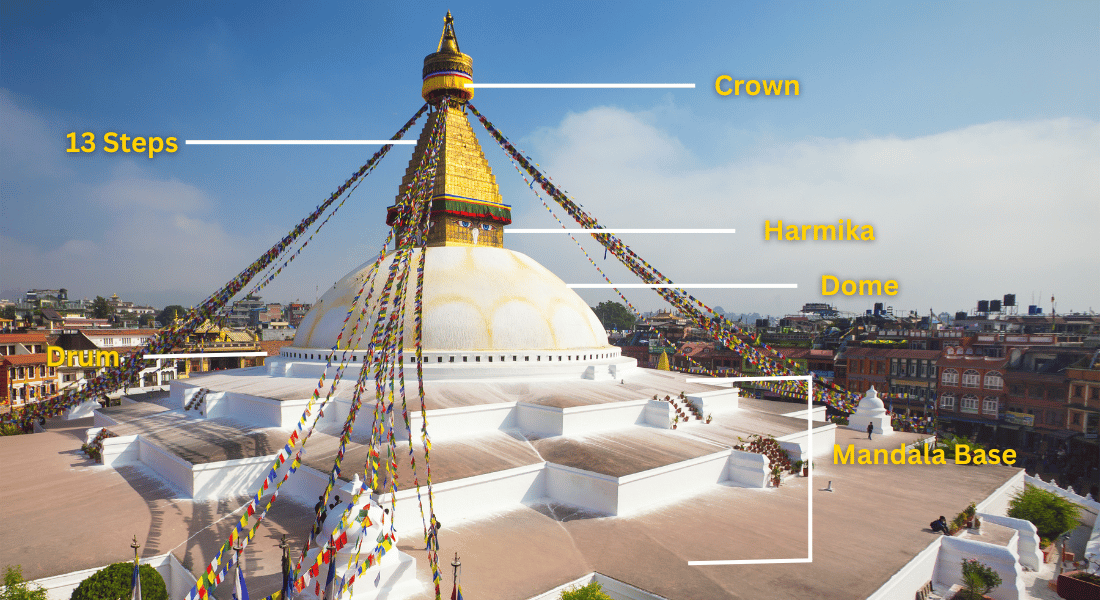
Base (3 Terrace Mandala Platform)
The first architectural piece of the Boudhanath Stupa is the 3-terrace mandala base platform sitting on top of each other upon which the remaining section of the stupa rests. The height of the first plinth (Mandala) is 7 feet, whereas the heights of the other two are about 6 feet each, all of which have 20 corners. On each corner of the north side of the first mandala are 4 small chortens and 2 on the south. Whereas at the entry point of the second mandala, there are two statues on either side, one of a warrior holding a shield in his left hand and a sword in the other and a girl figure holding a pot, both sitting on top of white elephants. These three mandalas are believed to symbolically represent the element of earth.
Drum
Just above the mandala sit the two circular drums, 4 feet in height together. The first drum is just a plain disc, whereas the second has 108 niches filled with stone images of deities, including past Buddhas, dakinis, bodhisattvas, and other Tibetan sages.
Dome
On top of the drum sits a semi-spherical dome, which is the major part of the stupa. The dome is believed to contain ancient remains of Kashyap Buddha, ancient artifacts, textbooks, and other relics. The dome is coloured all white using limestone and a set of lotuses is drawn at the top and bottom with saffron color. In Buddhism, the dome is considered to represent the water element.
Harmika
Above the dome sits a cuboidal shaped structure called the harmika, covered by gilded copper sheets. The harmika is adorned with the all-seeing, compassionate eye of Buddha on each visible side of the harmika. Above each pair of eyes, there is a third eye, which is regarded as the eye of consciousness. Below is a nose drawn like the number 1 written in Nepalese, which denotes singularity or unity of all things existing in the world.
13 steps spire
Crowning the cuboidal harmika is the 13 steps spire. It is shaped like a pyramid with steps and is covered by gilded copper sheets. The 13 step spire represents the 13 steps to achieve Buddhahood or attain liberation from the wheel of life. This section of the stupa represents the element fire.
Crown
The crown of the Boudhanath stupa is composed of 3 distinct sections representing different meanings. Above the spire sits a golden lotus, which symbolises spiritual enlightenment after fulfilling all the 13 steps of Buddhahood. On top of the golden lotus sits a golden umbrella with multicolour fabric hanging down, which represents the air element. Finally, the golden pinnacle, which represents the final stage of nirvana and the element ether or space. The pinnacle is also regarded as Mount Meru, the king of mountains.
Festivals of Boudhanath Stupa
Boudhanath Stupa, being one of the major religious sites in Nepal, hosts many Buddhist as well as Hindu festivals throughout the year. Here are some major festivals celebrated in Boudhanath.
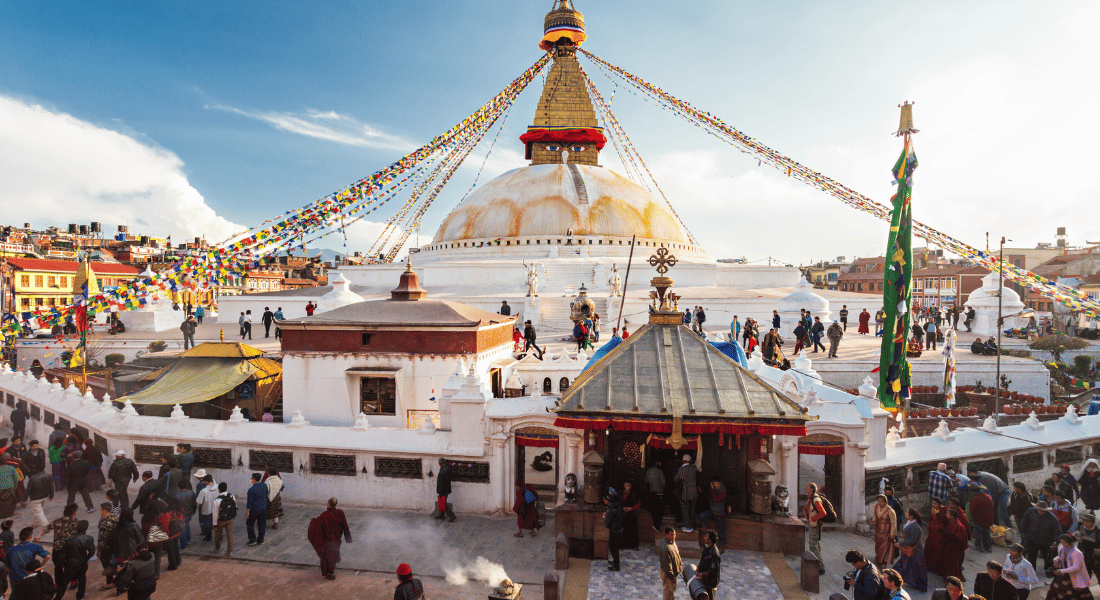
Mamla Jatra
Mamla Jatra, also known as Boudha Ajima Jatra, is a festival celebrated at Boudhnath in honor of Mamo Puska Siddhi, also known as Chhwaskaamuni Aji, who is regarded as the guardian deity of the Boudhanath area. It is celebrated on the Magha Purnima in the month of Magh (Jan/Feb). During this festival, the idol of Mam (Ajima) is taken out of the Ajima Temple on a palanquin, and a procession is carried out around the Boudha area. It is celebrated every year during the Magha Purnima, where people engage in musical performance, some carrying the palanquin and some carrying traditional fire torches.
Ropai Jatra & Gai Jatra
Ropai Jatra is an annual festival occurring during the month of August celebrated after completing the paddy plantation. Whereas Gai Jatra is a festival celebrated in the memory of parents or close relatives who have died the previous year. Both of these festivals are celebrated together at Boudhanath. During this event, participants dress up as farmers, ploughers, different gods and goddesses, cultural figures, politicians, animals, or anything else they want to be. Newari people are seen doing the ropai dance, showcasing the activity of plantation and other ethnic groups performing their own way of celebration.
Chechyu Puja
Chechyu Puja, also known as Rinpoche Day, is a Tibetan Buddhist festival that is dedicated to Guru Padmasambhava. This festival is celebrated every year on the tenth day of the tenth month of the lunar calendar, which usually falls between Mangsir/Poush of the Vikram Sambat calendar or December/January of the Gregorian calendar. On this day devotees perform traditional musical and masked dance performances and offer their prayers to honor Guru Padmasambhava.
Temal Jatra
The Temal Jatra is one of the major festivals of the indigenous people, the Tamangs, of the Temal area of the Kavre district. It is a 3-day-long festival in which, on the first day, these people come to the Boudhanath stupa and offer butter lamps and prayers, sing Phapare Geet, and circumambulate the stupa to pray for their loved ones who have passed away to attain moksha from the mortal world. On the second day, the pilgrims go to the Baish Dhara (22 water spouts) in Balaju and purify themselves by taking a holy bath. Then they walk to Swayambhunath Stupa and repeat the rituals of lighting butter lamps, prayers, and singing. And finally, on the third day, pilgrims walk to Namo Buddha in the evening to pray for their deceased loved ones and head back to their home in Temal.
Lhosar
Lhosar is a Tibetan festival that marks the start of the Tibetan new year, which is celebrated in Tibet as well as in Nepal. According to the Tibetan calendar, years are divided into 12 names of animals: mouse, ox, tiger, rabbit, dragon, snake, horse, sheep, monkey, bird, dog, and pig. The year replaces the next name of the animal in Lhosar. Majorly, the Sherpa, Tamang, Hyolmo, and Gurung communities in Nepal celebrate this festival according to their own timings. The Sherpas celebrate the Lhosar called the Gyalpo Lhosar; Tamangs and Hyolmos celebrate the Lhosar called Sonam Lhosar, whereas the Gurungs celebrate the Lhosar called Tamu Lhosar.
Buddha Jayanti
Buddha Jayanti is the major festival in Buddhism celebrated every year, commemorating Siddhartha Gautama’s birth, enlightenment, and mahaparinirvana. This festival is known by various names: Buddha Purnima, Baishakh Purnima, Vesak, etc. It falls during the full moon of Baisakh in the Vikram Sambat calendar or April/May in the Gregorian calendar. On this day, people from different communities gather at the Boudhnath and perform in engaging activities like singing and dancing. A procession of Gautam Buddha’s statue is also carried out around the Boudhanath area by people carrying Buddhist flags.
Places to Visit in Boudhanath
Boudhanath, being the central hub of Tibetan Buddhism in Nepal, is surrounded by around 50 Tibetan monasteries and some other significant attractions. Here are some of the must-visit places in the area if one is planning to explore Boudhanath.
Mamthan (Chhwaskamuni Aji Temple)
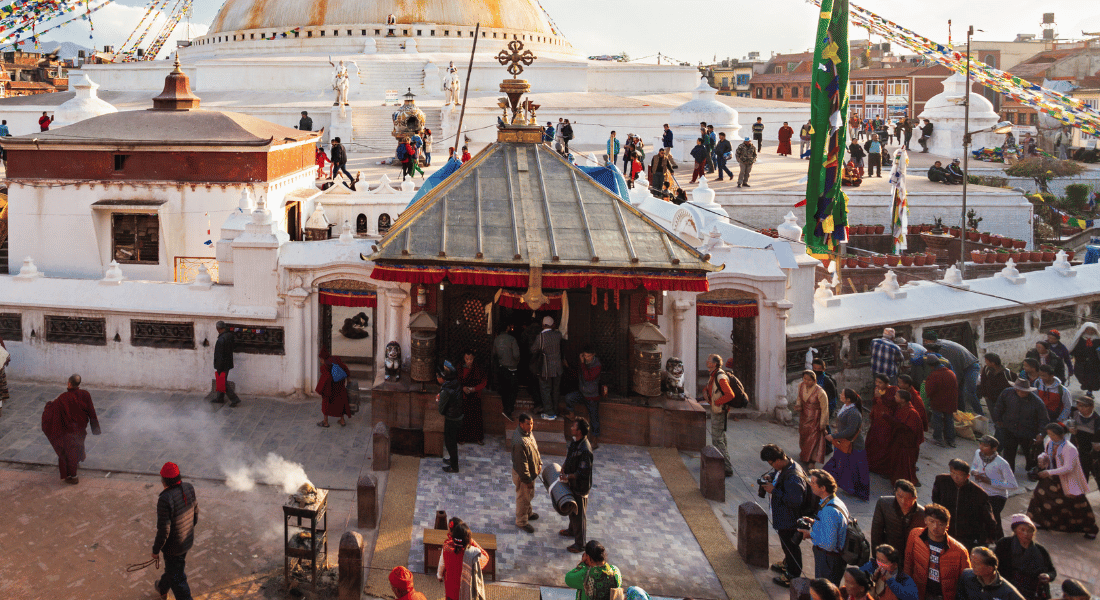
Located on the north side attached to the Boudhanath outer wall, the Mamthan, also known as the Chhwaskamuni Aji Temple or Harati Temple, is a small temple dedicated to Chhwaskamuni Aji/Harati. Harati is believed to be the guardian deity of the children. Before she became a deity, she was a fearsome demoness who used to abduct children and devour them, but after she met Buddha and got influenced by his compassion, she vowed to protect the children instead of harming them. As a reference to this tale, on this pagoda-style temple, the idol of goddess Harati is depicted eating something like the umbilical cord or an intestine of a baby on her lap.
Boudha Peace Park
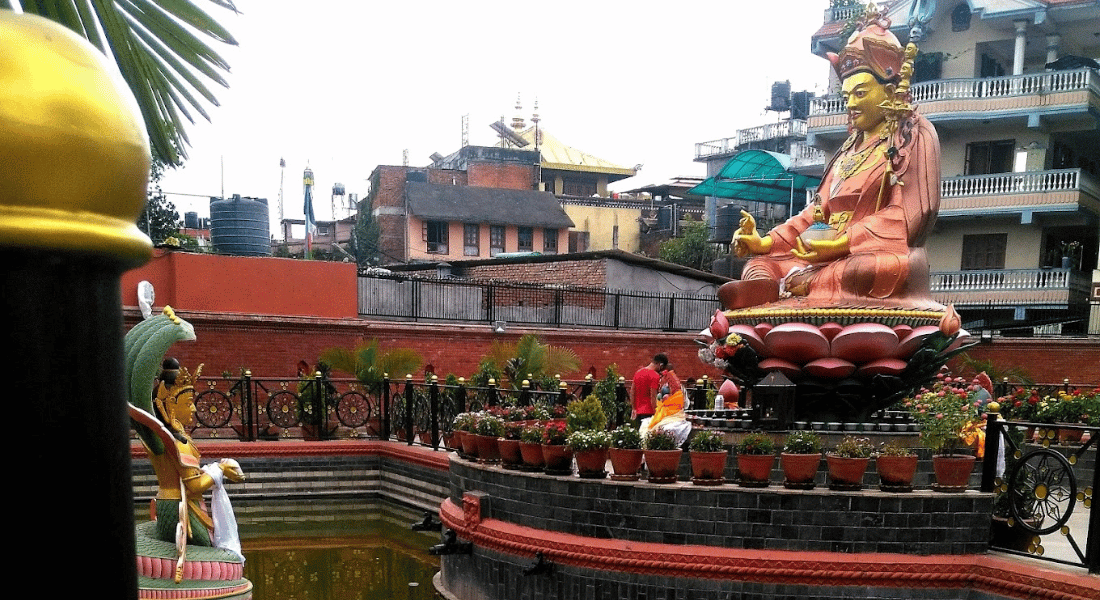
The Boudha Peace Park, also known as Ghyoilsang Peace Park, is a peaceful public park located northwest of the Boudhanath Stupa. It is widely believed that the soil used to make the Boudhanath Stupa was actually excavated from this exact location where the park is situated. The hole made from taking out the soil actually created a small pond here. This park was established in 2016 to mark the peaceful relationship between China and Nepal. With an area of 15,289.80 sq ft, the highlight of this park is the massive monument of Guru Rinpoche at the center of a pond. There is also a half-snake, half-human figure in front of the Guru Rinpoche’s statue and on the backside there are 8 small chortens. There are also sitting spaces on the side to enjoy the peaceful environment of this area.
Guru Lhakhang Monastery
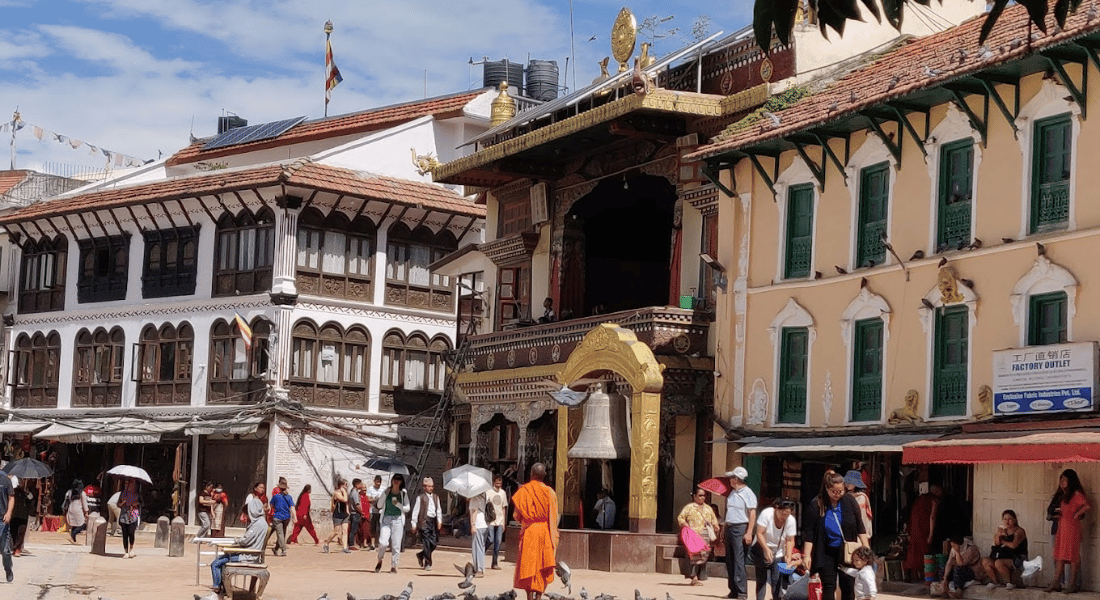
Situated to the north of the Boudhanath Stupa, opposite the Harati Temple, the Guru Lhakhang Monastery is the oldest Nyingma sect monastery in the area. Named after Guru Marmen Lhakhang, this monastery is also known as Tamang Monastery by locals. It is the most visited monastery here due to its prime location. One can identify the monastery by looking for a huge bell in front of the monastery. On the ground floor, there is a huge prayer wheel covered with mantras; it is believed that rotating the wheel is the same as reciting the mantras. On the first floor of the monastery, there are huge statues of different bodhisattvas, like Amitabha Buddha, Arya Avalokiteswara, Guru Padmasambhava, and others, murals on the walls, and monks praying on the side. On the rooftop, one can see a panoramic view of the Boudhanath Stupa as well as a small room with icons of different Buddhist figures.
Samteling Monastery
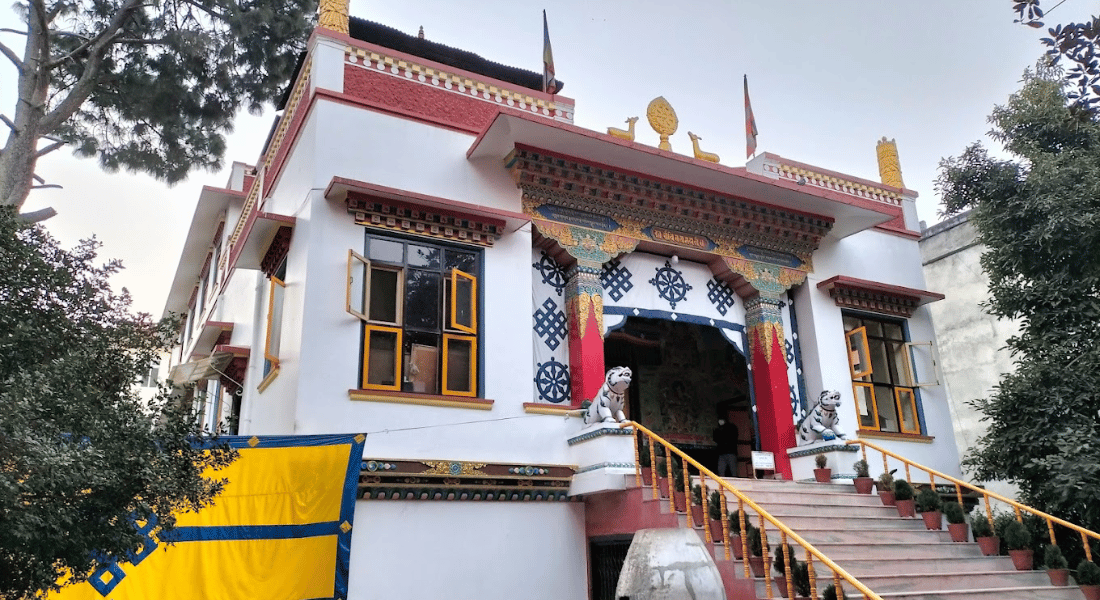
Located 60 metres east of the Boudhanath Stupa, Samteling Monastery is a Tibetan Buddhist monastery following the Gelug Tradition. It is the oldest and first-ever Tibetan monastery to be established in the Boudhanath area. The Samteling Monastery has a big prayer hall with artistic murals on the walls and roof, within which there are spaces separated for lamas to sit and recite mantras. As a part of the monastery, Samtenling School was established to provide the young monks of the monastery education from kindergarten through eighth grade.
Jhamchen Lhakhang
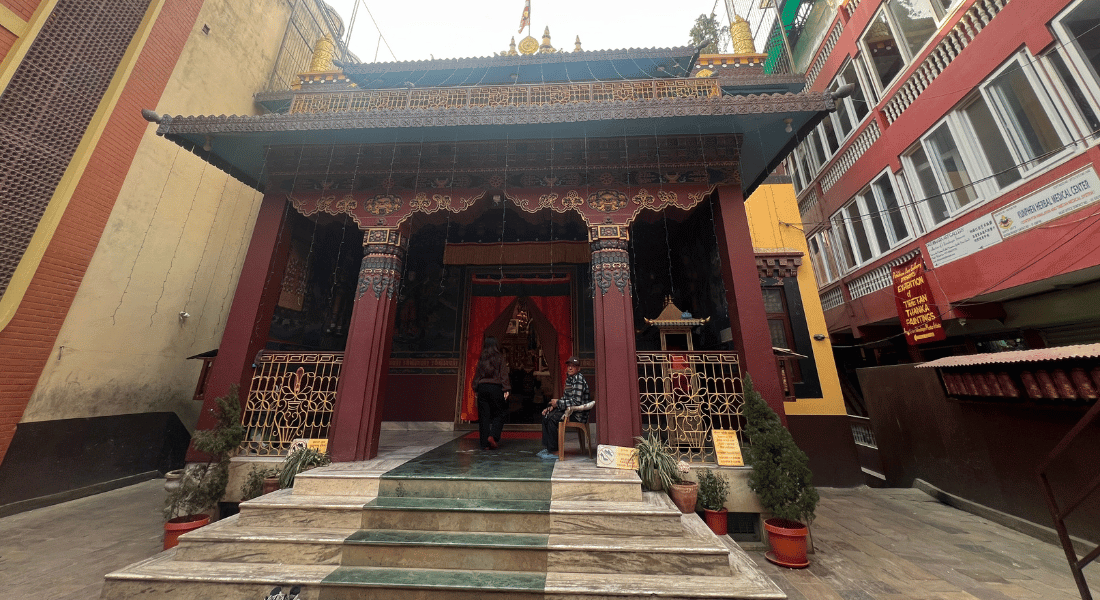
The Jhamchen Lhakhang, founded by Chyopeg Thichen Rinpoche in 1986 AD, is a monastery following Sakya tradition. Located on the west side of the Boudhanath Stupa, it is the first monastery that one will encounter if they enter through the main entrance gate and circumambulate clockwise. The monastery holds the almost 23-foot-tall beautiful Trikaal Maitreya Buddha’s (Gyalwa Jampa) idol, who is believed to make his appearance in the future. Additionally, as seen in other monasteries, the walls are decorated with interesting artwork and statues.
Things to do around Boudhanath
Boudhanath is not just a pilgrimage site; there are various activities one can do around the Boudhanath stupa. Here are some of them.
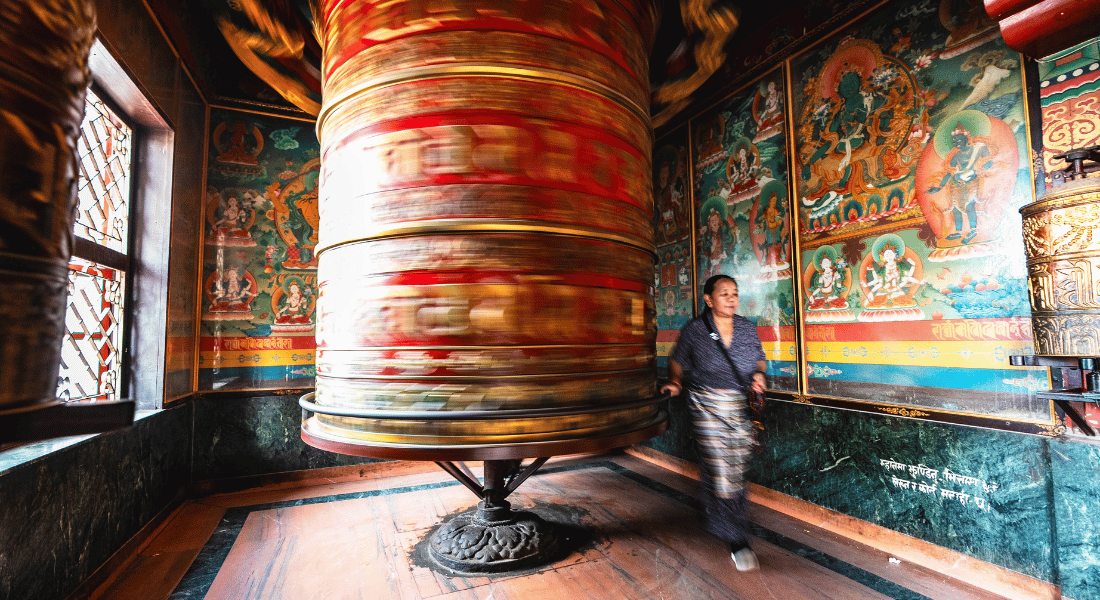
Circumambulate the Stupa
Circumambulation or Kora, is the sacred activity of going around a sacred object. As you enter the Boudhanath stupa area, circumambulate the outer portion of the stupa clockwise while turning the wheels attached on the outer boundary wall of the Boudhanath stupa. Visitors are allowed to enter the first plinth of the Boudhanath stupa and circumambulate the stupa from there too. The act of circumambulation is believed to bring good karma and blessings.
Buy Souvenirs and Handicrafts
There are several handicraft and souvenir shops scattered all over the Boudhanath area. These shops sell anything from branded to local handmade products like cashmere shawls, thanka paintings, singing bowls, prayer beads, jewleries, etc. Visitors can browse through the shops and buy some souvenirs and handicrafts they like, which also helps local businesses grow.
Visit Nearby Monasteries
There are around 50 monasteries surrounding the Bouddhnath stupa. Some of these monasteries might not be open for visitors. Some of the most visited monasteries one can go to during the circumambulation of the Boudhanath stupa that are open to visitors are the Guru Lhakhang Monastery and Jhamchen Lhakhang Monastery. Some of the monasteries around the stupa also offer meditation sessions and extended classes on Buddhism, if one is keen about it.
Enjoy Delicious Food
Various restaurants serving different cuisines can be found around Bouddhanath. Visitors can sit and enjoy the food while seeing the beautiful view of the Boudhanath stupa from the window seat. Some of these restaurants also offer rooftop service, where visitors can get an uninterrupted view of the stupa from the top, perfect for clicking some pictures and time-lapse.
Opening Time and Entry Fee
The Boudhanath Stupa square is open to the public 24/7; however, the entry to the stupa itself starts at 9 AM and closes at 6 PM and the surrounding monasteries have their own schedule.
|
Opening Time |
|
|
Stupa Complex |
24/7 (Ticket Counter: 06:00 AM to 07:00 PM) |
|
Boudhanath Stupa |
09:00 AM to 06:00 PM |
Visitors can obtain the entry pass to the Boudhanath area from various ticket counters around the stupa.
|
Entry Fee |
|
|
Foreign Nationals |
NRP 400 |
|
SAARC National |
NRP 100 |
|
Nepalese and Children below 10 |
Free |
How to Reach?
Located 8.6 km away from Tribhuvan International Airport (TIA) and 7.6 km from the famous tourist area Thamel, Boudhanath Stupa is accessible by various means.
Taxi
One easy and most common way if visitors are seeking to visit Boudhanath is by getting a taxi. If you are taking a taxi either from the Kathmandu Airport or the Thamel area, it should not cost more than NRP 700 to 800. Make sure to ask the taxi driver to drop you off at the Boudha Gate so that you don’t have to navigate further.
Public Vehicle
If one is feeling adventurous, they can take public vehicles available from different parts of Kathmandu City. It will obviously be an inexpensive travel way, as one-way travel will not cost more than NRP 50. Travelers can board public vehicles from Jamal, RNAC, or Chakrapath, major places to find public vehicles heading to Bouddha.
Conclusion
Boudhanath Stupa, being the symbol of peace, spirituality, and cultural harmony, has stood its ground since ancient times. Being one of the most popular Buddhist sites in Nepal, the stupa with its enormous presence and the watchful, compassionate eyes spreads its divine energy all over the world. Whether it is religious significance, architectural beauty, or simply a desire to take in the most peaceful atmosphere, this UNESCO World Heritage Site has a distinct enchantment in providing an enlightening experience. Besides being a spiritual hub, the architecture and mysterious origin attract thousands of keen visitors and pilgrims alike, making it a focal point. It requires a spare moment of time to wander around the stupa, spin the prayer wheels, and absorb the divine aura that has preserved Boudhanath as a shining light of peace.
Also Read: Lumbini - The Birthplace of Gautam Buddha

